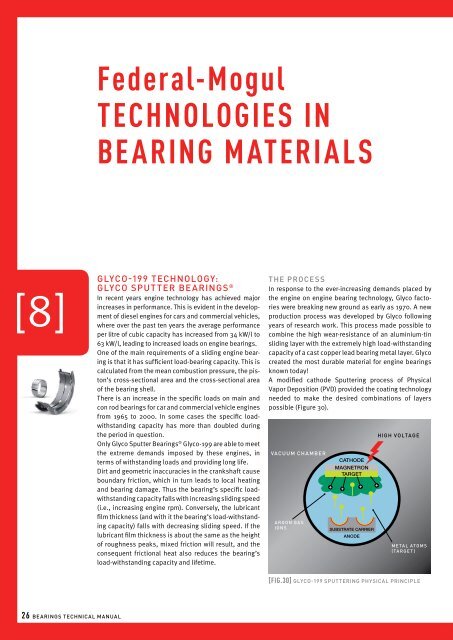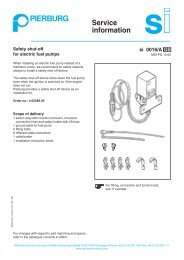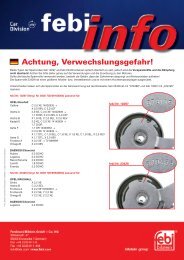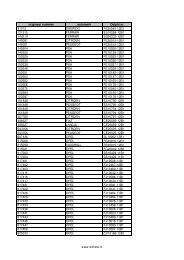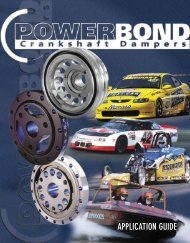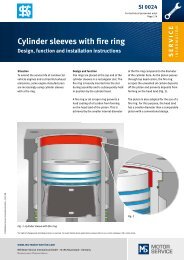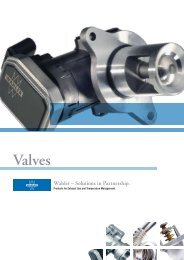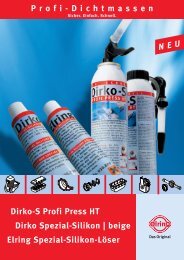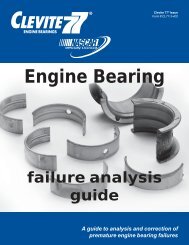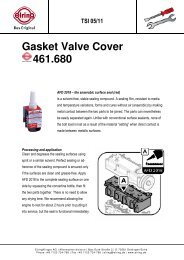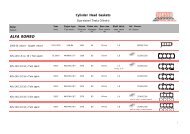EvEry bEaring you nEEd
EvEry bEaring you nEEd
EvEry bEaring you nEEd
Create successful ePaper yourself
Turn your PDF publications into a flip-book with our unique Google optimized e-Paper software.
[8]<br />
Federal-Mogul<br />
technologies in<br />
bearing materials<br />
GLYCO-199 technology:<br />
GLYCO Sputter Bearings ®<br />
In recent years engine technology has achieved major<br />
increases in performance. This is evident in the development<br />
of diesel engines for cars and commercial vehicles,<br />
where over the past ten years the average performance<br />
per litre of cubic capacity has increased from 34 kW/l to<br />
63 kW/l, leading to increased loads on engine bearings.<br />
One of the main requirements of a sliding engine bearing<br />
is that it has sufficient load-bearing capacity. This is<br />
calculated from the mean combustion pressure, the piston’s<br />
cross-sectional area and the cross-sectional area<br />
of the bearing shell.<br />
There is an increase in the specific loads on main and<br />
con rod bearings for car and commercial vehicle engines<br />
from 1965 to 2000. In some cases the specific loadwithstanding<br />
capacity has more than doubled during<br />
the period in question.<br />
Only Glyco Sputter Bearings ® Glyco-199 are able to meet<br />
the extreme demands imposed by these engines, in<br />
terms of withstanding loads and providing long life.<br />
Dirt and geometric inaccuracies in the crankshaft cause<br />
boundary friction, which in turn leads to local heating<br />
and bearing damage. Thus the bearing’s specific loadwithstanding<br />
capacity falls with increasing sliding speed<br />
(i.e., increasing engine rpm). Conversely, the lubricant<br />
film thickness (and with it the bearing’s load-withstanding<br />
capacity) falls with decreasing sliding speed. If the<br />
lubricant film thickness is about the same as the height<br />
of roughness peaks, mixed friction will result, and the<br />
consequent frictional heat also reduces the bearing’s<br />
load-withstanding capacity and lifetime.<br />
The process<br />
In response to the ever-increasing demands placed by<br />
the engine on engine bearing technology, Glyco factories<br />
were breaking new ground as early as 1970. A new<br />
production process was developed by Glyco following<br />
years of research work. This process made possible to<br />
combine the high wear-resistance of an aluminium-tin<br />
sliding layer with the extremely high load-withstanding<br />
capacity of a cast copper lead bearing metal layer. Glyco<br />
created the most durable material for engine bearings<br />
known today!<br />
A modified cathode Sputtering process of Physical<br />
Vapor Deposition (PVD) provided the coating technology<br />
needed to make the desired combinations of layers<br />
possible (Figure 30).<br />
VACUUM CHAMBER<br />
Argon Gas<br />
Ions<br />
CATHODE<br />
MAGNETRON<br />
TARGET<br />
SUBSTRATE CARRIER<br />
ANODE<br />
HIGH VOLTAGE<br />
Metal Atoms<br />
(Target)<br />
[fig.30] Glyco-199 Sputtering physical principle<br />
In Sputtering, a dispenser cathode of an aluminium-tin alloy is<br />
bombarded by argon plasma, causing the aluminium and tin atoms<br />
to deposit as lining on the specially prepared engine bearings. The<br />
Physical Vapor Deposition (PVD) process produces an exceptionally<br />
even alloy matrix, offering outstanding resistance to wear and to<br />
very high loads. The structure of Glyco Sputter Bearings ® makes<br />
the reasons for their high performance clear. The bond between<br />
the die-cast leaded bronze bearing metal layer and the sliding<br />
surface is strengthened by an intermediate layer of pure nickel,<br />
which is circa 2 µm thick (Figure 31).<br />
ca. 16 µm<br />
ca. 2 µm<br />
0.2-0.3 mm<br />
[fig.31]<br />
Sputter Layer<br />
of Tin & Aluminium<br />
Nickel<br />
Inter-Layer<br />
CuPb22Sn<br />
Lead-bronze Layer<br />
Nickel prevents the diffusion of atoms between<br />
the Lead-bronze and the Sputter<br />
Commercial vehicle engines fitted with Glyco Sputter Bearings ®<br />
achieve lifetimes of one million km, and engine manufacturers<br />
are now working to increase this to one million miles.<br />
Computer-controlled processes incorporating high cleanliness<br />
and precision standards lead to uniform high quality in mass production.<br />
Under extreme loads, even minimal discrepancies can<br />
be detrimental to the bearing’s reliable functioning – therefore<br />
100% fault-free production is essential.<br />
Repair and running tips for<br />
GLYCO Sputter bearings ®<br />
The hardness of the Sputter layer gives the bearing extremely<br />
high wear resistance and high fatigue resistance. The Sputtered<br />
AISn20 layer is sensitive to the contamination of the lubricant oil<br />
with particles, water or alkaline elements, the last of which can<br />
get into the engine oil via anti-freeze in the coolant water.<br />
To ensure that engine repairs are carried out correctly, these Glyco<br />
Sputter Bearings ® characteristics must be taken into account.<br />
Under high loads the oil film thickness decreases, so that even<br />
very small contaminant particles can penetrate it. On the other<br />
hand, the hard Sputter layer’s high wear resistance means that it<br />
adapts more slowly to the unevenness of the crankshaft’s surface.<br />
As a consequence, the crankpins and the housing bores must be<br />
in optimum condition in terms of geometry and surface roughness.<br />
During running the loads can cause the housing bore to deform.<br />
The original bearing can adapt to this deformation during running,<br />
but when new bearings are installed the reduced play in the deformation<br />
zones can lead to the destruction of the lubrication film. For<br />
these reasons the housing bores must also be carefully finished.<br />
In comparison to conventional surfaces, the increased surface<br />
hardness of the layers of the Glyco Sputter Bearings ® reduces<br />
the capacity to bed-in contaminant particles. Accordingly, Glyco<br />
Sputter Bearings ® are, as a rule, composed of a bearing shell with<br />
a Sputter layer plus a bearing shell with a softer running surface.<br />
The Sputter shell is fitted in areas exposed to high loads, while<br />
the softer shell is used in the vicinity of the engine bearing,<br />
which is subject to lower load. The softer half of the bearing shell<br />
is more able than the Sputter layer to absorb the contaminant<br />
particles contained in the oil.<br />
This engineering solution has proved best in practice. Nevertheless,<br />
the careful cleaning of all engine parts and the lubrication<br />
system and also the utmost cleanliness when repairing and<br />
assembling the engine are vital prerequisites for successful<br />
maintenance. Any residual dirt must be removed by rinsing the<br />
stationary engine before the engine is started for the first time.<br />
Where the maximum permissible engine rpm is n max, the following<br />
running-in programme has been established:<br />
Step 1 1 min 1 /3<br />
Step 2 1 min 1 /4<br />
Step 3 1 min 1 /2<br />
Step 4 1 min 1 /3<br />
n max<br />
n max<br />
n max<br />
n max<br />
During running-in, the engine performance should not exceed<br />
15 to 20% of maximum load.<br />
26 Bearings Technical Manual<br />
27


